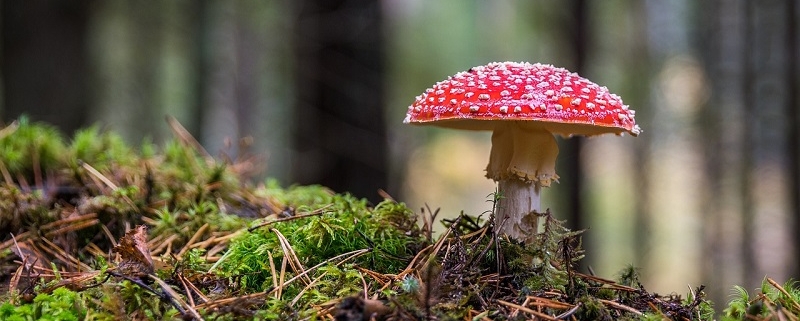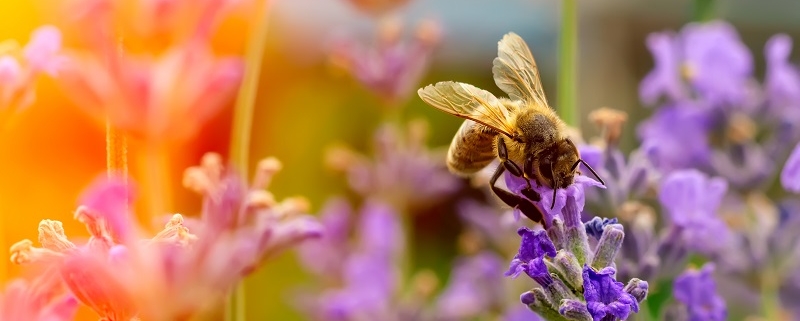Death, Decay and Decomposition: The Underappreciated Parts of Nature — Plus the Winners of our Insect Hotel Contest!
We’ve all heard that death is a natural part of life — and when we examine the ecosystems around us, it becomes clear just how true this is. While many associate the wonders of nature with new life, like a flower unfurling its petals or a robin’s egg hatching, the decay of living things is just as amazing when you stop to examine it. With the leaves changing colors and falling, autumn is the perfect time to appreciate the important role that death and decay play in the natural world. Make sure to read to the end of the blog to see the winners of this year’s insect hotel contest and learn how these designs incorporated dead plants and other recycled materials.
If a tree falls in the woods…
Tree mortality is a common part of a forest ecosystem. In addition to normal aging, trees also succumb to weather-related issues, insects or drought. Depending on their species, trees can live anywhere from 20 years to several thousand years — but either way, through natural or unnatural means, trees will die. When this happens, they often fall to the forest floor and become nurse logs. These logs provide nutrients for other trees and shrubs, as crevices in fallen trees will often fill with soil, moss and mushrooms. This contributes to the creation of humus, the moisture- and nutrient-rich organic matter created through plant and animal decomposition. The humus in these nurse logs serves as a natural seedbed, meaning that the end of one tree’s life can be the beginning of another’s.
However, not all dead trees fall, and when they are left standing in place, dead trees are called snags. Snags play an important role in providing habitat for birds and small mammals like squirrels. More than 85 species of birds in North America alone nest in the cavities of snags, and insectivorous birds like the downy woodpecker also rely on snags as a source of insects. Nurse logs and snags prove that, even when they are no longer living, trees support a host of life in the forest ecosystem.
The only good kind of litter
Anyone taking a walk through the woods during the autumn months has probably noticed the iconic crunch of leaves underfoot. Those crunchy, dead leaves make up the leaf litter layer of the forest floor, an important part of the ecosystem. The dead plant material like leaves, twigs and bark comprising the leaf litter helps cycle nutrients into the soil as it decomposes. Leaf litter makes up a significant source of the nitrogen, phosphorus and trace mineral elements that healthy soil requires.
Much like snags, leaf litter also provides shelter and food resources for small animals like birds, insects, invertebrates and even microscopic bacteria. For many of these creatures, the warmth and shelter afforded by leaf litter makes a safe place to hibernate during the winter. In fact, leaving a leaf litter in the backyard rather than raking up fallen leaves is a simple way to support these species!
Let’s hear it for the decomposers
Breaking down dead and decaying matter is an important job carried out by organisms known as decomposers. This includes fungi like mushrooms and mold, which use special proteins and enzymes to break down decaying organic matter and cycle carbon and essential nutrients back into the soil. Some types of pathogenic fungi will even attach to and kill trees, creating breaks in the canopy that allow lower-growing plants to receive more sunlight.
Decomposers exist beyond the plant kingdom — there are many animals, called detritivores, that ingest dead organic matter. From earthworms to wood lice, detritivores serve an important role in the food chain. Some decomposers even take part in a process known as nitrogen fixation, which transforms nitrogen in the soil into a form that plants can use.
Keep calm and carrion
Decomposing animal matter, also known as carrion, may not be the most pleasant sight (or smell), but it is a food source for a variety of species. From calliphorid flies and carrion beetles to striped hyenas and black vultures, carrion-eating animals help escalate the decomposition process and return nutrients back to the soil. Carrion scavengers have adapted to eating rotten meat without suffering any adverse effects, often due to specialized digestive bacteria and acids that destroy any toxic bacteria in their food. Some species, like the Virginia opossum, will even eat the bones of dead animals for calcium, leaving no part of a dead creature going to waste.
Give dead matter a new life
We’ve seen how the natural decomposition process benefits the environment — but how can corporate conservation teams incorporate these processes into a habitat project? In addition to leaving snags in place and supporting the needs of carrion scavengers, one simple and creative idea is to recycle dead plant matter and found materials into insect hotels. These structures provide habitat for bees, beetles and other insects, with items like dead twigs, leaves and bark offering shelter and nesting space.
This year, WHC held a contest to find the best insect hotels around the world. The contest received 21 incredible entries, and while each was an excellent example of an insect hotel, WHC determined a winner for each of the following categories — congratulations to the winners!
- Best Large-Size Hotel – General Motors Argentina
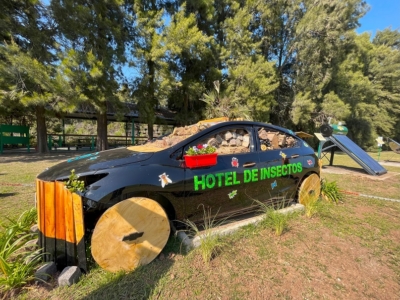 Located on the grounds of the GM Rosario Plant in Santa Fe, Argentina, this bug hotel was housed in the body of a car that was going to be disposed of. Instead of throwing it away, employees repurposed the car into a hotel filled with wood pallets, logs with pre-drilled holes, nesting tunnels, twigs, bark and the remains of other vegetation – making this structure an excellent example of how dead matter can still support life.
Located on the grounds of the GM Rosario Plant in Santa Fe, Argentina, this bug hotel was housed in the body of a car that was going to be disposed of. Instead of throwing it away, employees repurposed the car into a hotel filled with wood pallets, logs with pre-drilled holes, nesting tunnels, twigs, bark and the remains of other vegetation – making this structure an excellent example of how dead matter can still support life.
- Best Small to Mid-Size Hotel – Olympus Energy
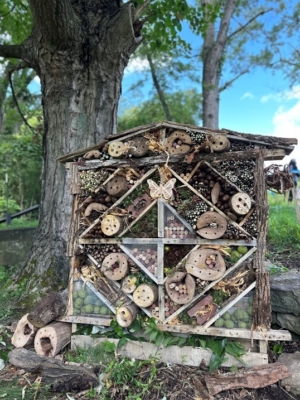 Olympus Energy used this insect hotel to supplement an existing pollinator garden at its site in Jeannette, Pennsylvania. Volunteers supplied recycled materials found at their homes or at work sites, including bricks, wooden pallets, pinecones, walnuts, woody stems and untreated logs. The design of the hotel was inspired by the farmhouse and barn previously on the property, a way to honor the past while creating a new structure for the future.
Olympus Energy used this insect hotel to supplement an existing pollinator garden at its site in Jeannette, Pennsylvania. Volunteers supplied recycled materials found at their homes or at work sites, including bricks, wooden pallets, pinecones, walnuts, woody stems and untreated logs. The design of the hotel was inspired by the farmhouse and barn previously on the property, a way to honor the past while creating a new structure for the future.
- Best Use of Found Materials – Conservation Blueprint
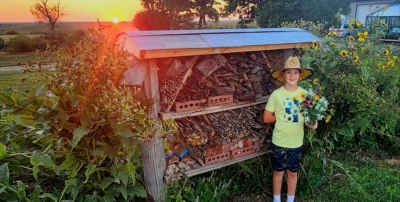 The construction of this insect hotel in Saint Paul, Nebraska, was a collaborative effort, drawing on the skills of an entire family. Situated in the middle of a wildflower garden at a prairie conservation company, this hotel provides shelter for native bees and wasps. The design incorporated dried milkweed pods, mud rock with holes, bark, cut stems from the last growing season, bamboo sticks and pieces of tin roofing from an old barn. By the halfway point of the construction process, the hotel was already being used by pollinators.
The construction of this insect hotel in Saint Paul, Nebraska, was a collaborative effort, drawing on the skills of an entire family. Situated in the middle of a wildflower garden at a prairie conservation company, this hotel provides shelter for native bees and wasps. The design incorporated dried milkweed pods, mud rock with holes, bark, cut stems from the last growing season, bamboo sticks and pieces of tin roofing from an old barn. By the halfway point of the construction process, the hotel was already being used by pollinators.
- Best Renovation of an Existing Hotel – WM Southern Services Landfill
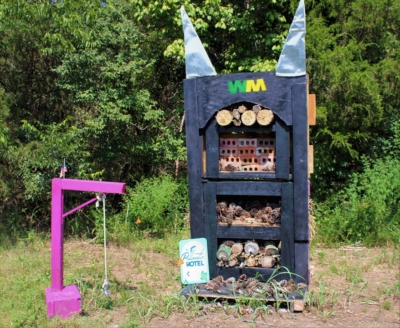 WM chose to renovate an existing bug hotel at its Southern Services Landfill site in Nashville, Tennessee. The team modeled the hotel after Nashville’s AT&T Tower, also known as the “Batman Building,” doubling the height of the existing bug hotel and adding pointy “ears” to match the famous skyscraper. Intended for bees, butterflies, wasps and beetles, the hotel even includes pinecones whose sap attracts specific insects.
WM chose to renovate an existing bug hotel at its Southern Services Landfill site in Nashville, Tennessee. The team modeled the hotel after Nashville’s AT&T Tower, also known as the “Batman Building,” doubling the height of the existing bug hotel and adding pointy “ears” to match the famous skyscraper. Intended for bees, butterflies, wasps and beetles, the hotel even includes pinecones whose sap attracts specific insects.
Bug hotels come in a variety of shapes, sizes and designs, and the contest entries included many creative designs using reclaimed materials found on the site.
For example, at its Dresden Wildlife Site in Dresden, Ohio, CRH Americas got creative and reused the body of an old Komatsu cab to house the materials for its insect hotel. Companies also got into the team spirit, like Marathon Petroleum Corporation’s M-shaped hotel at its Heath Ohio Station site. Team members can use bug hotel projects to flex their artistic muscles, like the Avantor entry at a site in Buckshaw Village, England, that incorporated a sun design to represent the ultimate source of life.

Many of the bug hotels entered in the contest used the construction process as an educational opportunity, illustrating how this project can involve the community. For example, at CEMEX’s Planta Huichapan in Huichapan, Mexico, students from the site’s environmental restoration program learned about the native species in the pollinator garden, received guidance on the design and performed observations of the species that visited. Meanwhile, in Baldwinsville, New York, a Boy Scout troupe installed an insect hotel at the Beaver Lake Nature Center. Not only was the design and construction of this hotel a learning opportunity for the Boy Scouts, but the finished product will also go on to educate nature center visitors. At Flint Hills Resources in Corpus Christi, Texas, local middle school students were instrumental in the collection of materials, including an old dresser that would otherwise have been collected for the garbage.

These examples of decomposition show that even when an organism has died, it still plays a greater role in the overall health of the ecosystem. From leaf litter to carrion eaters to bug hotel materials, death and decay play a necessary role in life.
